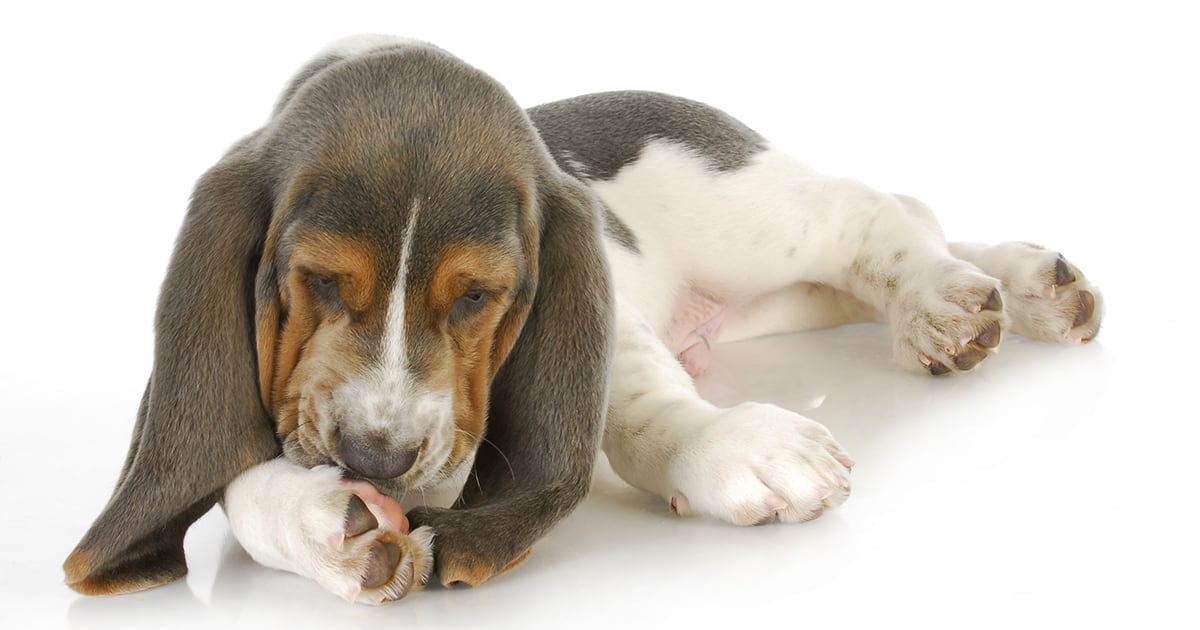Getting a Grip on Your Dog’s Pododermatitis

A little licking at the paws, now and then, is just basic hygiene for most dogs. But some pups get carried away, licking and gnawing until their paws are red and swollen. There may be open sores, areas of hair loss and reddish-brown saliva staining light-colored fur. For some dogs, the paws become painful, causing them to favor the paw and limp when walking.
This is what’s known as pododermatitis, or inflammation of the skin of the paw. Pododermatitis can occur on any area of the paw, including the skin between the toes, the foot pads, the skin around the nails or the nails themselves. One or more paws may be involved, but the front paws tend to be more commonly affected.
Pododermatitis is more a description than a diagnosis. It’s typically a sign of an underlying disease process, which can be difficult to diagnose. The signs may wax and wane or the problem can become chronic unless the underlying disease (or diseases) is identified and properly treated.
A Multitude of Possible Causes
There are many possible causes of pododermatitis, and some dogs may have multiple disease processes at work. A few common causes of pododermatitis include:
- Underlying allergies — These may include environmental allergies (also known as atopic dermatitis) to irritants like dust mites, plant pollens and mold spores; cutaneous food allergies; and contact allergies, or allergies to materials that come in contact with the paws. These allergies can cause an itching sensation, which the dog tries to relieve by licking or chewing at the paws, sometimes leading to secondary bacterial or fungal (including yeast) infections.
- Parasites — Among other parasites, dogs may be infested with Demodex mites, which are tiny, microscopic parasites. These mites may result in lesions in the paws only or in other parts of the body as well.
- Trauma and other conditions — Paws may be affected by foreign bodies such as slivers, cysts, immune system disorders, hormonal or metabolic diseases, poor paw conformation, obsessive behaviors, cancer and more.
Casting a Wide Diagnostic Net
Because there are many potential causes of pododermatitis, your veterinarian will ask you important questions about your dog’s habits and give your dog a thorough exam to search for other signs of underlying disease.
Diagnostics will typically include skin cytology, or a study of cells under the microscope, to look for inflammatory cells, bacteria, yeast and parasites. Debris from skin scrapings and hair plucking will be viewed under a microscope to look for signs of parasites. Your veterinarian may also recommend bacterial and fungal cultures as well as skin biopsies.
To help identify other underlying causes, additional tests may be needed including blood and urine tests, X-rays of the paws to evaluate the bones and look for foreign bodies and food trials to test for potential food allergies.
Because diagnosis can be complicated, it may take weeks to months to pinpoint the exact cause(s). It’s important to have patience and return for follow-up appointments, so the right treatment, that can bring the dog relief, can be provided.
Management and Treatment
Treatment will vary depending on the underlying cause. For bacterial or fungal infections, treatment may include topical paw shampoos, soaks or wipes, as well as oral antibiotic or antifungal medications. Steroids may be administered to help reduce swelling and inflammation.
If there are masses or foreign bodies, surgery may be required.
In the case of an underlying allergy or immune-mediated disease, the problem may never be completely cured, but it can usually be managed with medications or hypoallergenic foods. Treatment may be lifelong, but dogs can do quite well.
It’s also important to keep dogs from licking and chewing the paws, further traumatizing the skin. Your veterinarian may recommend booties or inflatable collars to help discourage licking.
The ultimate prognosis for pododermatitis depends on the diagnosis. With the right treatment, licking and chewing can be minimized so dogs can be more comfortable.
